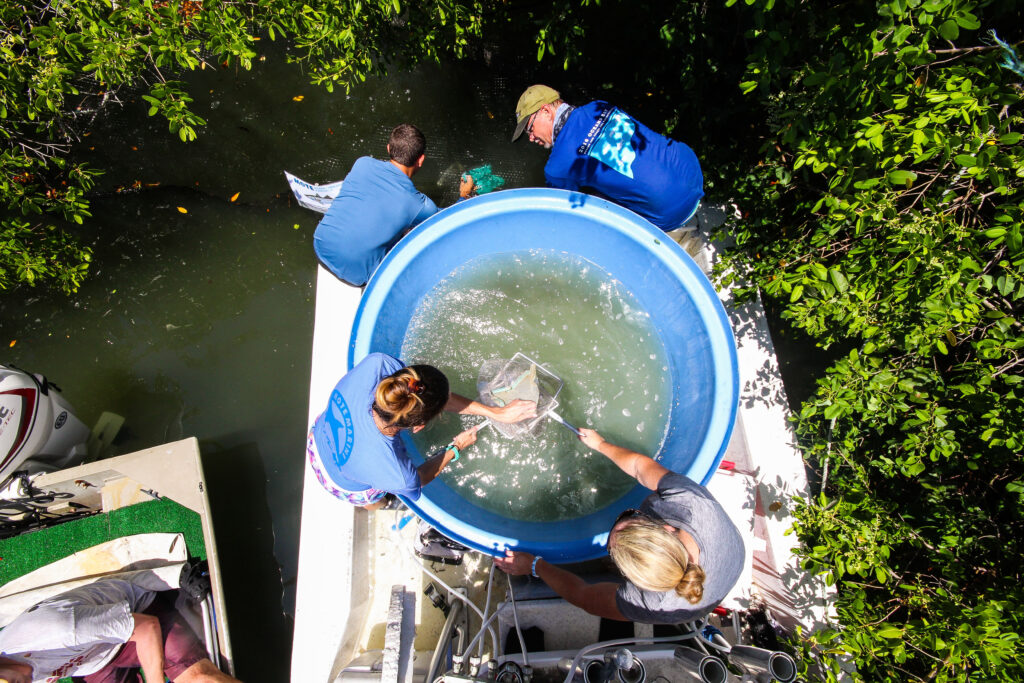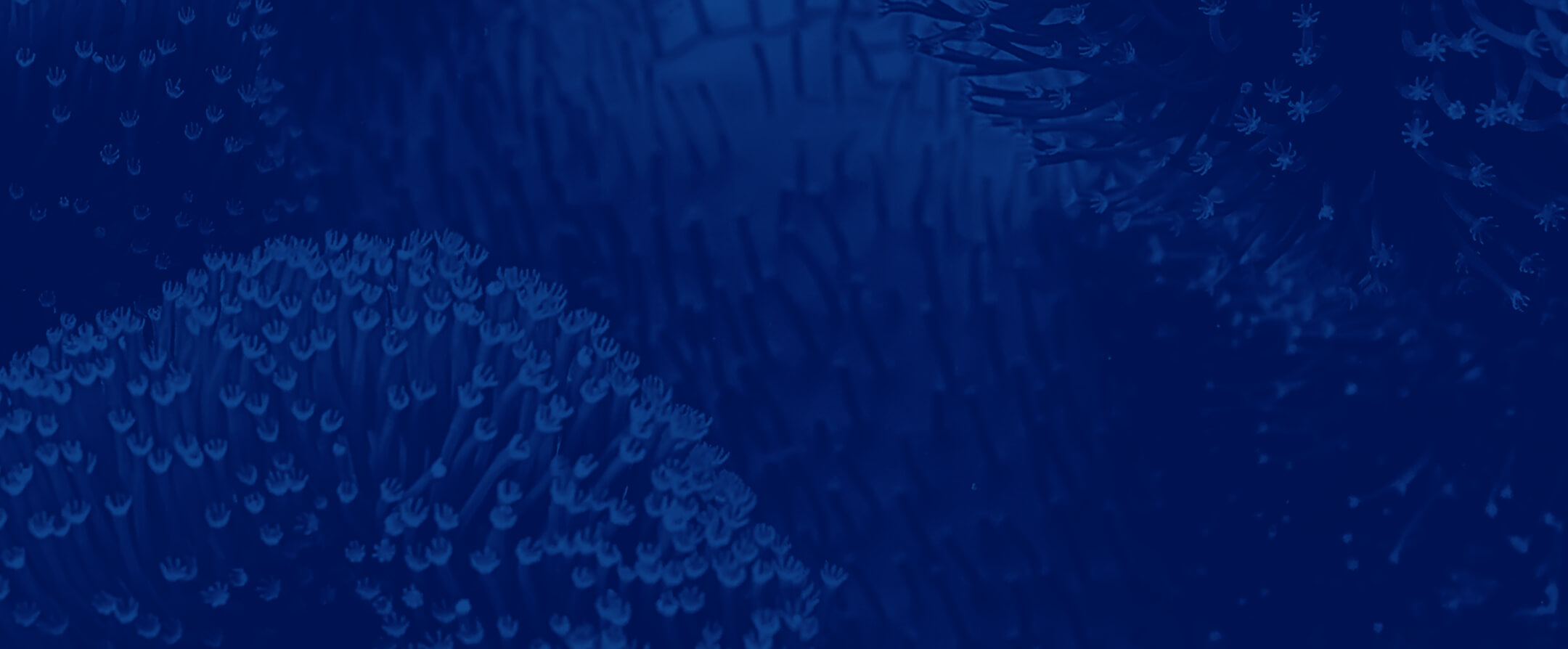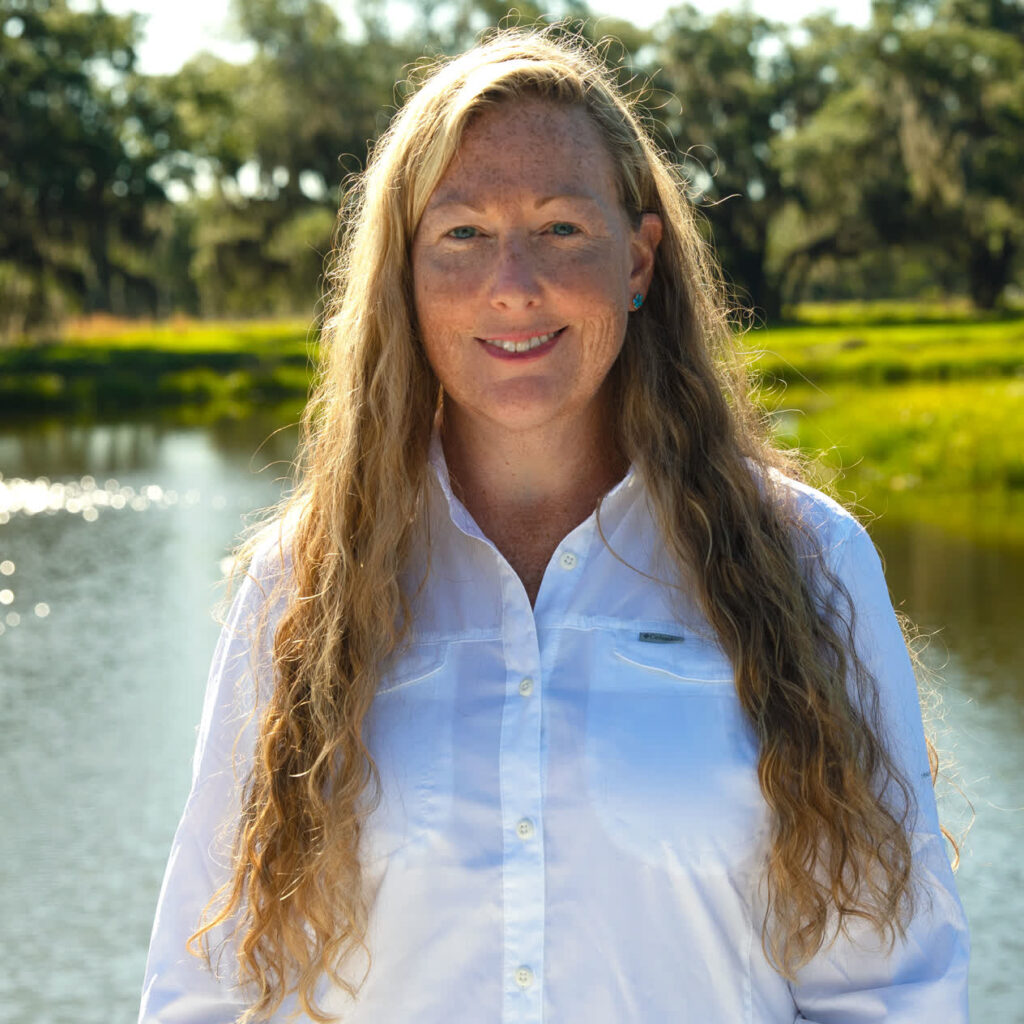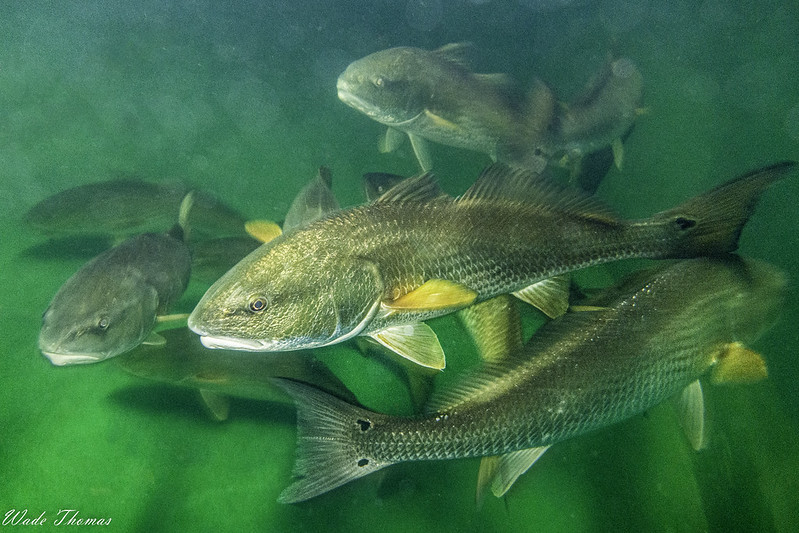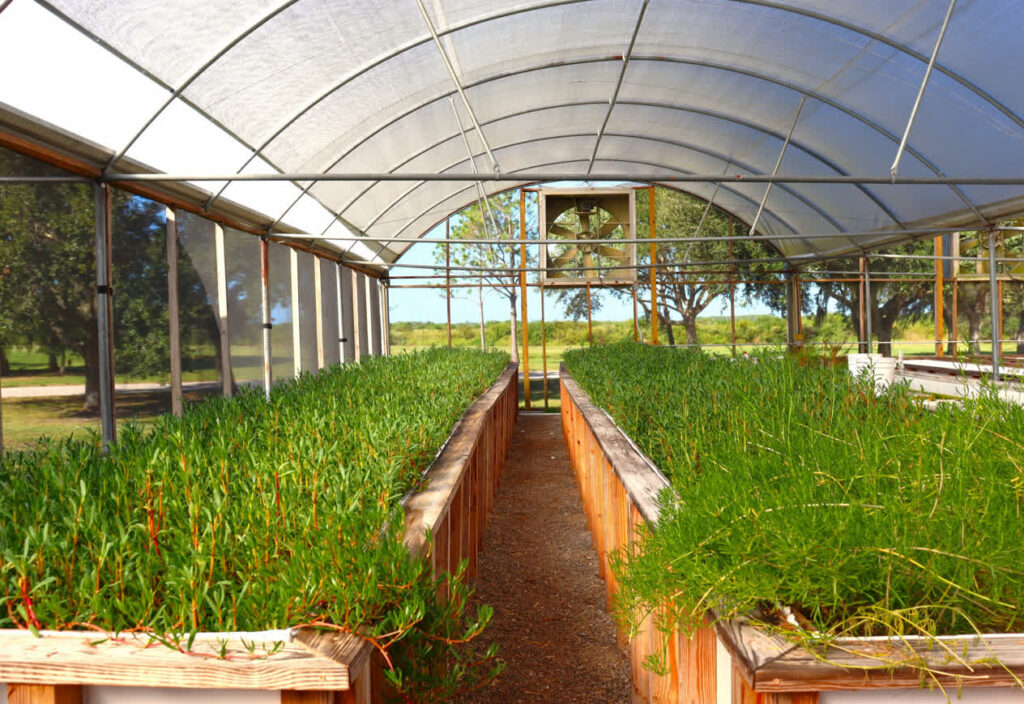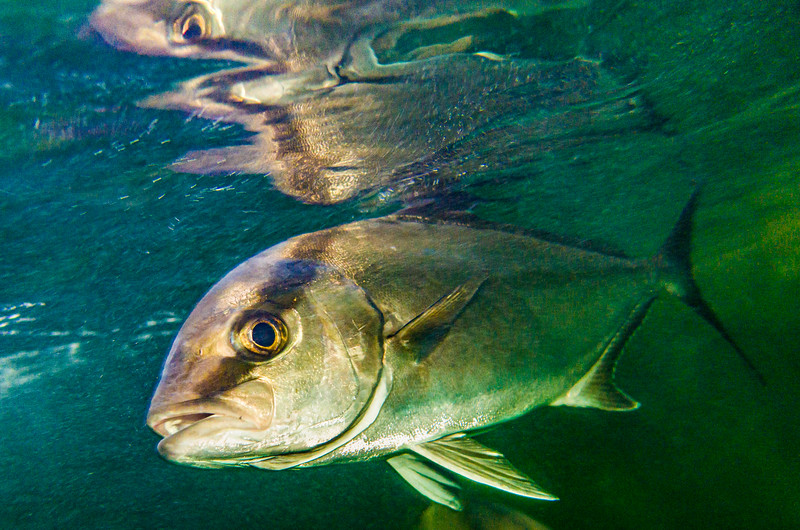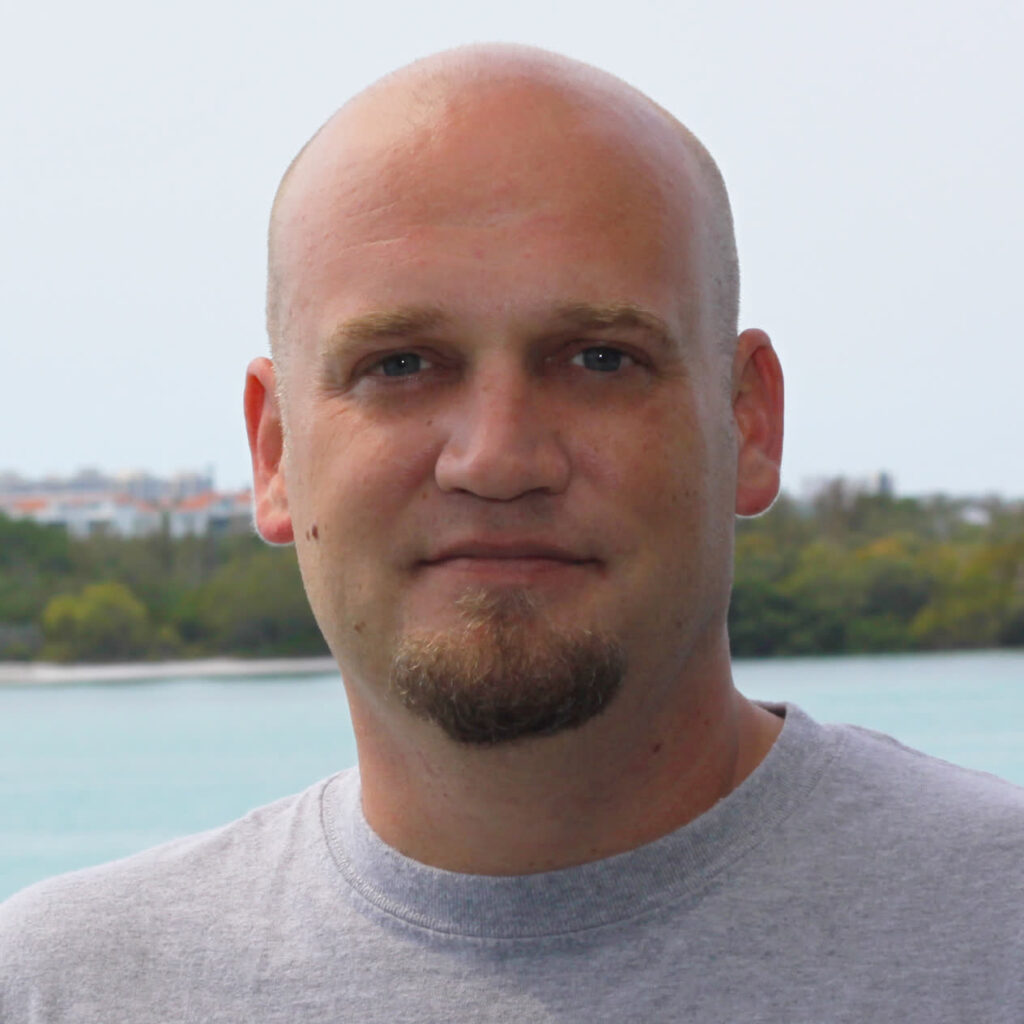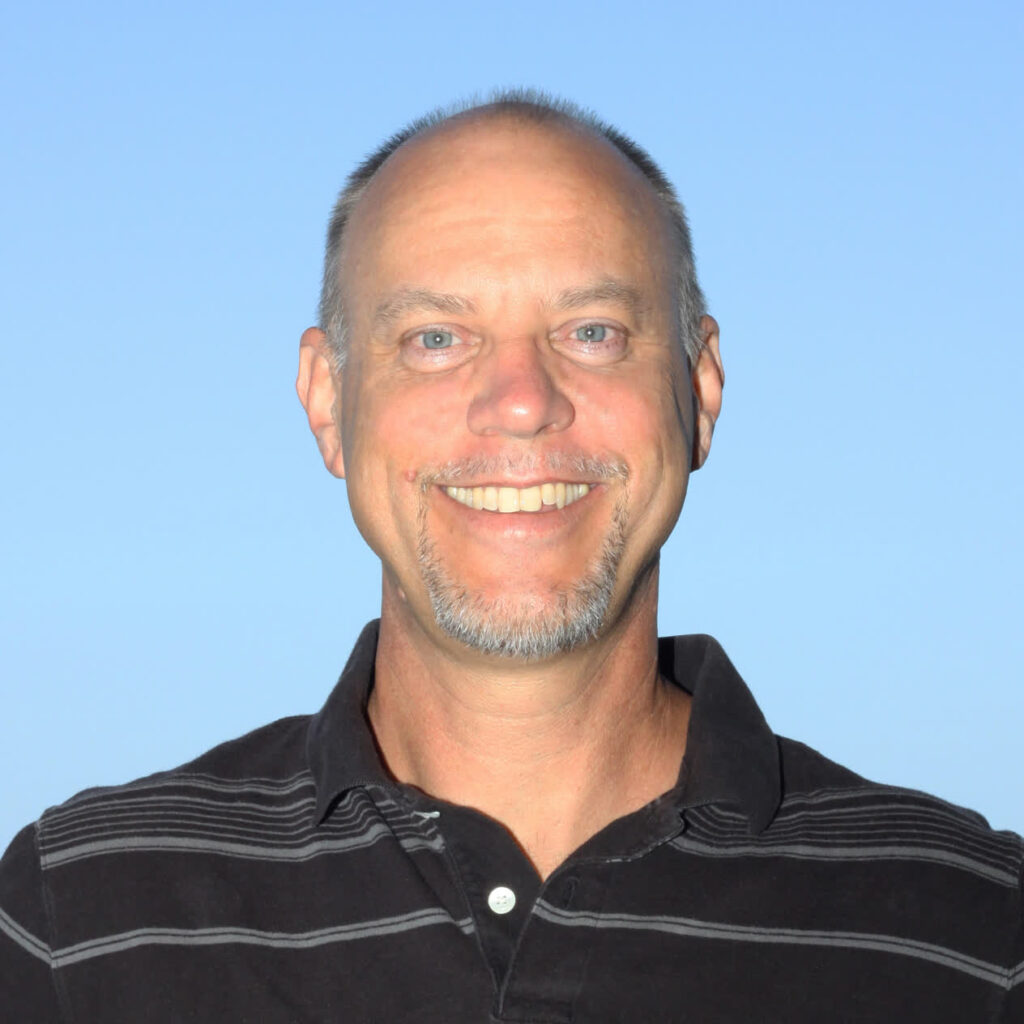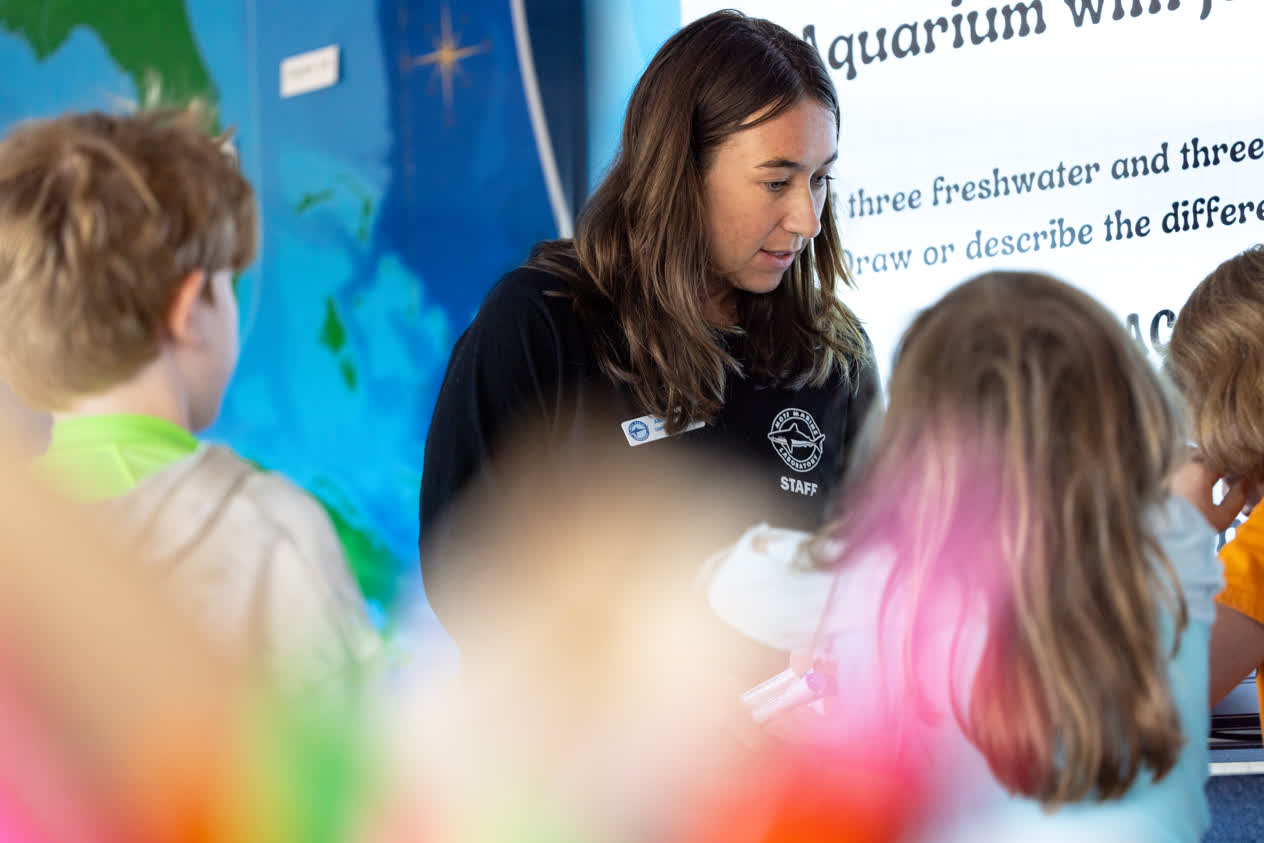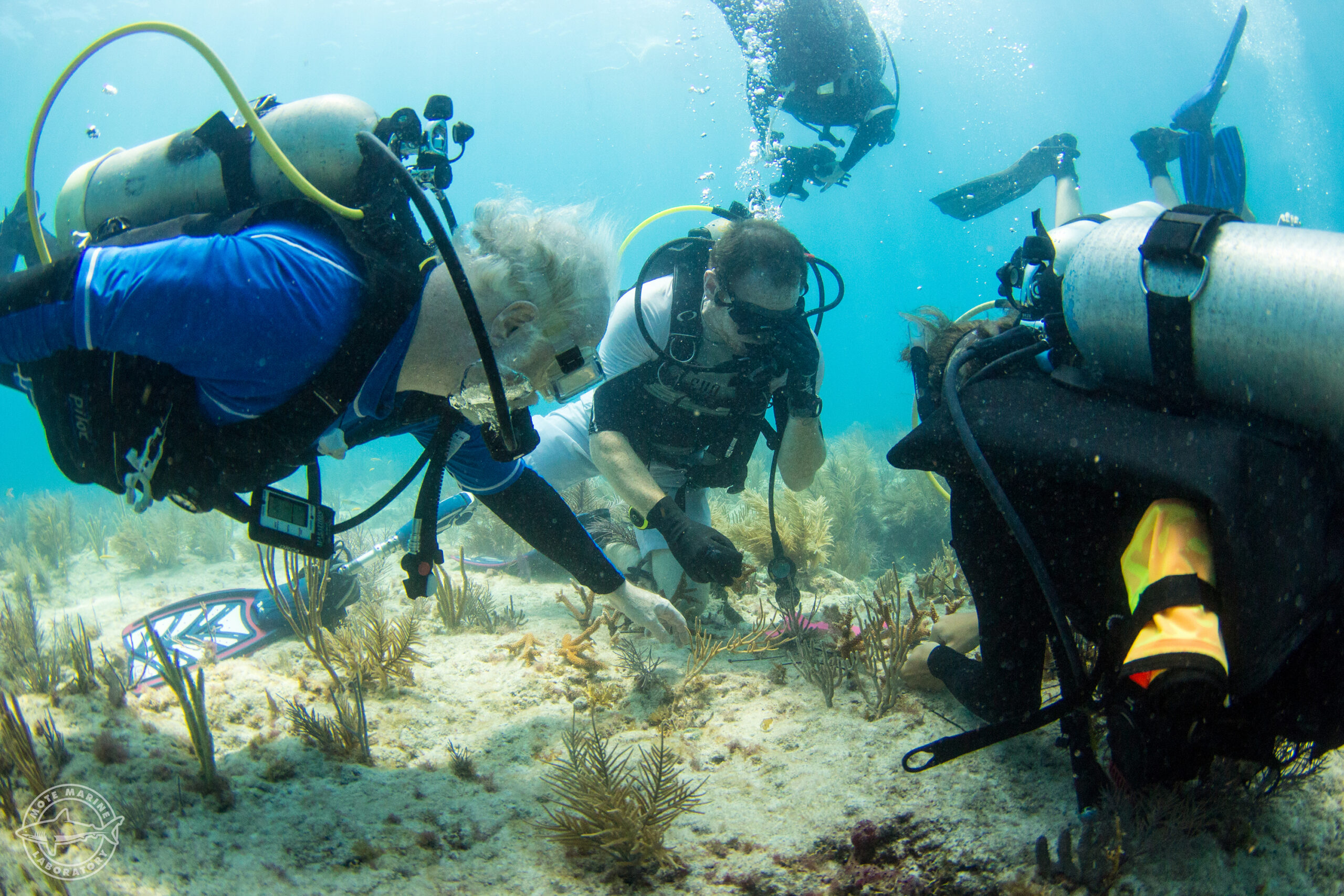The mission of the Marine & Freshwater Aquaculture Research Program is to develop innovative technologies and systems to support sustainable aquaculture to meet the growing global demand for seafood and to restore declining recreational fishery stocks. This mission is accomplished through applied research, hands-on training programs, and partnerships with industry, educational and research institutions, and government agencies.
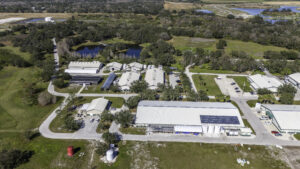
Mote Marine Laboratory’s aquaculture researchers know that positive change depends on the best available science—and that’s what we strive to provide. Mote Aquaculture Research Park in Sarasota County, Florida demonstrates how to raise seafood away from the coast, while recycling 100% of the salt water.
Mote’s progress reveals how precisely our science targets urgent, pressing questions to advance the production of sustainable food. At Mote Aquaculture Research Park, we are developing innovative, ecologically friendly and cost effective water filtration and animal husbandry techniques to produce high-value marine and freshwater species. Our team is pioneering marine aquaponics research, replenishing snook and red drum, developing hatchery technologies for emerging species (for example, mullet, Almaco Jack, Florida Stone crab), and partnering with industry and research professionals around the world to advance sustainable aquaculture technologies.
At Mote Aquaculture Research Park in Sarasota, Florida, we combine environmental sustainability with economic feasibility, demonstrating that cost-effective, land-based aquaculture systems can produce saltwater fish and sea vegetables, while recycling 100% of their water. Mote’s innovative recirculating aquaculture systems are also supplying juvenile fish to restore declining fishery stocks.
Program Details
Pioneering Marine Aquaponics systems
Recirculating aquaculture systems (RAS) that filter and reuse water are environmentally compatible, conserve precious water resources, provide biosecurity to protect farmed animals from disease, and ensure good water quality conditions for farmed species. Mote research is directed at designing and testing filtration systems that utilize nutrients to produce multiple crops, while cleaning the water. Marine aquaponic systems produce multiple species (such as fish, edible sea vegetables, wetland plants, periphyton), utilize excess nutrients to provide additional saleable products, and improve the economic feasibility of RAS and marine aquaponic systems.
In 2014, Mote initiated a project to develop a small-scale marine aquaponics system based on the established technology for freshwater aquaponics in collaboration with the University of South Florida and Morningstar Fishermen. The goal is to provide expanded opportunities for local, community-based food production. A low-salinity, brackish water system will be used to produce red drum (Sciaenops ocellatus) and edible sea vegetables (sea purselane and saltwort). Solid fish waste produced by the aquaponics system will be used to fertilize wetland plants for coastal restoration projects with Aquatic Plants of Florida.
Replenishing snook and red drum
For more than 25 years, Mote has partnered with the Florida Fish and Wildlife Conservation Commission (FWC) to grow high-quality eggs, larvae and juvenile common snook (Centropomus undecimalis) to restore wild populations. Mote was the first to mature and spawn this species in captivity in 2006. Larval research today is focused on optimizing conditions for larval and juvenile fish growth and survival, including identifying ways to reduce juvenile fish cannibalism and to improve swimbladder inflation during early larval development. Snook produced by Mote’s Aquaculture team are used by Mote’s Fisheries Ecology and Enhancement Program to advance stock enhancement research. Prior to release, snook are marked (e.g., with tags) to identify optimal release strategies.
In 2023, Mote’s Aquaculture and Fisheries Ecology & Enhancement Programs worked together to successfully raise and release 20,000 red drum fish in Sarasota and Charlotte counties with the goal of replenishing red drum populations that have been negatively affected by events such as cold stuns and Florida red tide.
Advancing hatchery technologies
Spawning and/or rearing technologies for marine fishes and invertebrates have been investigated for a wide range of species, including Common snook, Grey Mullet, Pacific snook, Florida pompano, Atlantic tripletail, southern flounder, greater amberjack, Almaco jack, red drum, red snapper, zebrafish, abalone, shrimp, hard corals and long-spined sea urchins.
Industry driven research
An applied research project was recently completed to investigate aquaculture solutions to help shellfish farmers address red tide challenges. The shellfish farming industry has declined significantly in recent decades along Florida’s Gulf Coast, facing challenges including severe Florida red tides caused by toxin-producing Karenia brevis algae. Shellfish in red tide areas accumulate the toxins and cause neurotoxic shellfish poisoning if eaten. For this reason, shellfish farmers are required by law to close their harvest areas when red tide cell counts reach a specific threshold. Closures due to red tide can cause devastating economic impacts to some of the largest shellfish fisheries in the United States. Utilizing funding awarded from the Mote-FWC Florida Red Tide Mitigation & Technology Development Initiative, USDA AFRI, and Saltonstall-Kennedy competitive grants programs, Mote scientists are working hard to provide shellfish growers with new tools and systems technologies which help producers better manage their seafood crops during red tide blooms.
Mote’s aquaculture scientists have worked with private companies to develop technology for farming emerging aquaculture species sustainably: Red Drum, Florida stone crabs, and Grey Mullet are examples of species that are in development. These collaborations exemplify how Mote scientists translate and transfer our discoveries to support eco-friendly aquaculture growth.
Georgia Aquarium
Mote is partnered with the Georgia aquarium to produce sustainable sources of food (red drum and mullet) for animals.
Florida Fish and Wildlife Conservation Commission (FWC)
FWC, stakeholder communities and local anglers are using tech we’ve developed together for over 30 years to support fisheries enhancement as a rapid response to changing environments (wild red drum and snook population recovery).
Salt Strong
With Salt Strong, Mote raised and released the largest number of hatchery-reared red drum in its history, boosting survival of the stocked fish, enabling monitoring their post-release behavior, and helping promote sustainable fisheries.
Mote’s Aquaculture team has partnered with UF/IFAS extension Sarasota County to develop the Beginning Farmer Education Program with the goal of creating the future Florida workforce in food, sustainable farming, and natural resources. This 8-week program provides the next generation of farmers with hands-on work experience and practical education under the mentorship of Mote scientists, extension educators, successful entrepreneurs, and local producers. “Mote continues to successfully demonstrate how to raise seafood away from the coast while recycling 100% of the salt water—and we’ve built upon that core technology to do much, much more,” said Manager of Mote’s Marine & Freshwater Aquaculture Research Program, Dr. Nicole Rhody. “Mote’s progress reveals how precisely our research targets urgent, pressing questions in our national conversation on food security and sustainable seafood resources. We hope this program combines what we know about taking environmentally-friendly aquaculture to a commercial scale and how we can apply those methods by enhancing the success of new farm start-ups, to help increase access to more locally grown foods.”
Beginning Farmer Education Program Launched
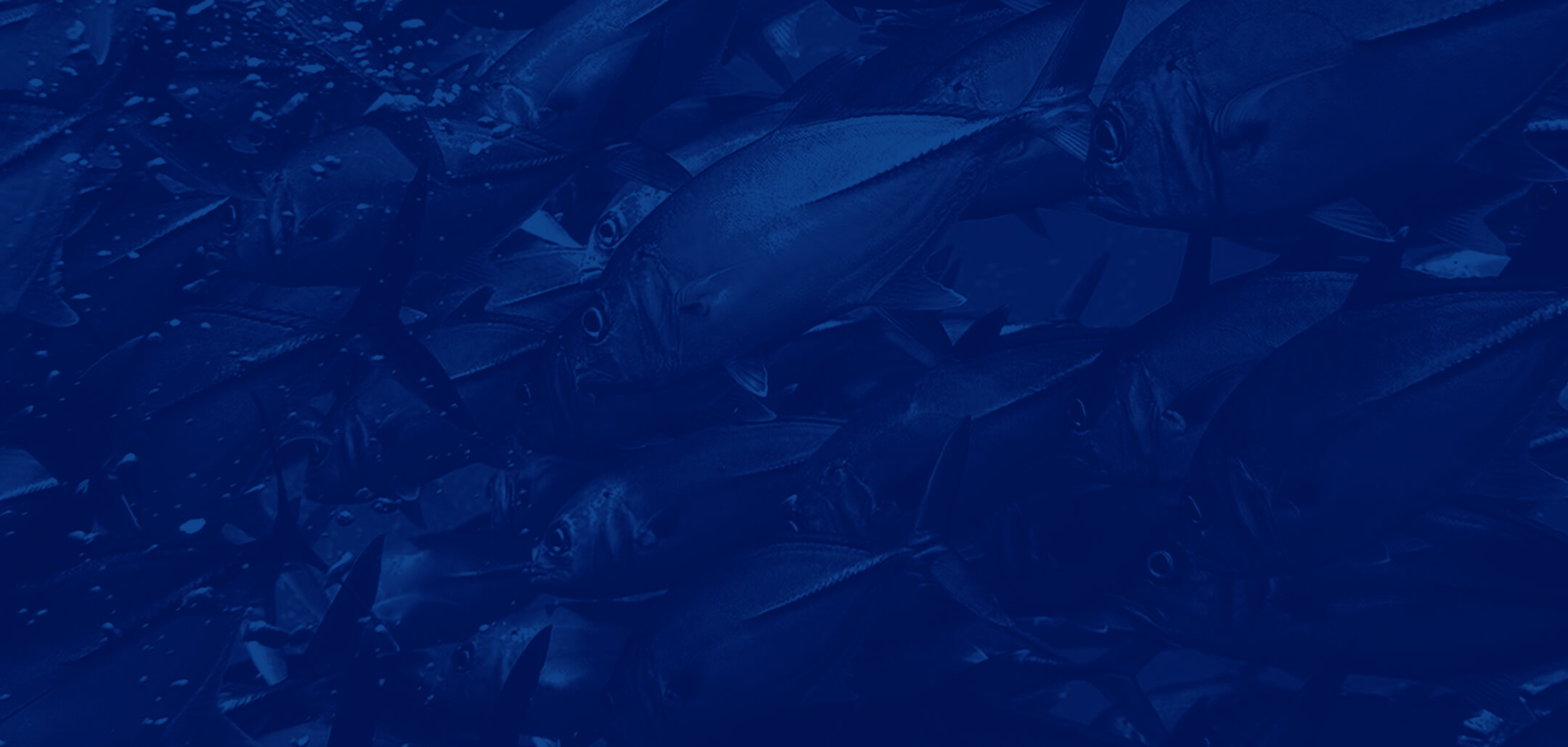
Additional Program Information
- He, Q., Z. Cheng, D. Zhang, K. Main, C. Feng, S.J. Ergas (2020). A sulfur-based cyclic denitrification filter for marine recirculating aquaculture systems. Bioresource Technology 310 (2020) doi.org/10.1016/j.biortech.2020.123465
- Hans, R., R. Schloesser, N. Brennan, R. Ribeiro, K.L. Main (2019). Effects of stocking density on cannibalism in juvenile common snook Centropomus undecimalis. DOI:10.1111/are.14353
- Patrick, G., A.M. Tarnecki, N. Rhody, R. Schloesser, K. Main, R. Yanong, R. Francis-Floyd (2019). Disinfection of Almaco jack (Seriola rivoliana Valenciennes) eggs: Evaluation of three chemicals. Aquaculture Research doi.org/10.1111/are.14342
- Waldrop, T., K.L. Main, A. Tarnecki, N. Brennan and E. Boggis (2019) Mullet-based diets show promise as aquafeed ingredient. Global Aquaculture Advocate, Vol. 194, Aug. 12, 2019.
- Guttman, L., A. Neoria, S.E. Boxman, R. Barkana, B. Shahara, A.M. Tarnecki, N.P. Brennan, K.L. Main and M. Shpigel (2019) An integrated Ulva-periphyton biofilter for mariculture effluents: Multiple nitrogen removal kinetics. Algal Research 42 (2019) 101586
- Tarnecki, A.M., M. Wafapoor, R.N. Phillips, and N.R. Rhody (2019) Benefits of a Bacillus probiotic to larval fish survival and transport stress resistance. Sci. Rep. 9, 4892. doi:10.1038/s41598-019-39316-w.
- Tarnecki, A.M., N.P. Brennan, R.W. Schloesser and N.R. Rhody (2019) Shifts in the Skin-Associated Microbiota of Hatchery-Reared Common Snook Centropomus undecimalis During Acclimation to the Wild. Microb. Ecol. 77, 770–781. doi:10.1007/s00248-018-1252-7.
- Main, K.L., D.L. Wetzel, R. Grams, M.J. Nystrom, K. Niebuhr and J. Lewis. (2018) Utilizing recirculating aquaculture systems to evaluate the impact of oil toxicity on marine fishes: Design and operation of a large-scale experimental system. Marine Technology Society Journal 52(6):23-31.
- Tarnecki, A.M., Rhody, N.R. Walsh, C. (2018) Health Parameters and Blood Bacterial Assemblages of Healthy Captive Red Drum Sciaenops ocellatus: Implications for Aquaculture and Fish Health Management. Journal of Aquatic Animal Health. http:https://doi.org/10.1002/aah.10047
- Boxman, S. M. Nystrom, S.J. Ergas, K.L. Main, and M.A. Trotz. (2018) Evaluation of water treatment capacity, nutrient cycling, and biomass production in a marine aquaponic system. Ecological Engineering 120 (2018): 299-310.
- He, Q., Zhang, D., Main, K., Feng, C., and S.J. Ergas. (2018) Biological denitrification in marine aquaculture systems: A multiple electron donor microcosm study. Bioresource Technology 263(2018): 340-349.
- Yanes-Roca, C., M.E. Toledo-Cuevas, L.J. Sanchez, A.Born-Torrijos, N. Rhody and K.L. Main (2017) Digestive enzyme activity during larval development of black snook, Centropomus nigrescens. J. World Aquaculture Society https: doi.org/10.1111/jwas.12466
- Pulster, E.L., K. Main, D. Wetzel, and S. Murawski (2017) Species-specific metabolism of naphthalene and phenanthrene in 3 species of marine teleosts exposed to Deepwater Horizon crude oil. Environmental Toxicology 2017: 1-9. https://doi.org/10.1002/etc.3898
- Merz, C.R. and K.L. Main. (2017) Microalgae bioproduction – Feeds, foods, nutraceuticals, and polymers. IN: Fuels, Chemicals and Materials from the Oceans and Aquatic Sources, Edited by Kerton, F.M. and N. Yan. John Wiley & Sons Ltd
- Ma, Q., S. Seyoum, M.D. Tringali, M.J. Resley, N.R. Rhody, K.L. Main, K.M. Leber (2017) Evaluating spawning performance among captive Florida pompano Trachinotus carolinus broodstock using microsatellite-based parentage assignment. Aquaculture Research 2017:1-12. https://doi.org/10.1111/are.13369
- Boxman, S. M. Nystrom, J.C. Capodice, S.J. Ergas, K.L. Main, and M.A. Trotz. (2016) Effect of support medium, hydraulic loading rate, and plant density on water quality and growth of halophytes in marine aquaponic systems, Aquaculture Research 2016: 1-15. DOI:10.1111/are.13083
- Salze, G.P., D.A. Davis, M. Resley, N. Rhody, K. Main, K. Stuart, and M. Drawbridge. (2015) Advances in understanding of taurine functions in fishes across species and life stages. XIII International Symposium on Aquaculture Nutrition. Hermosillo, Sonora, México November 11-13 2015.
- Boxman, S.E., A. Kruglick, B. McCarthy, N.P. Brennan, M. Nystrom, S.J. Ergas, T. Hanson, K.L. Main, and M.A. Trotz. (2015) Performance evaluation of a commercial land-based integrated multi-trophic aquaculture system using constructed wetlands and geotextile bags for solids treatment. Aquacultural Engineering 69: 23-36.
- Boxman, S., K.L. Main, M. Nystrom, S. J. Ergas and M. Trotz. (2015) Aquaponic system produces red drum, saltwater vegetable species. Global Aquaculture Advocate, July/August, 2015: 58-60.
- Rhody, N. R., A. Davie, N. Zmora, Y. Zohar, K. L. Main, and H. Migaud (2015) Influence of tidal cycles on the endocrine control of reproductive activity in common snook (Centropomus undecimalis). General and Comparative Endocrinology 224:247–259.
- Hauville, M. R., N. R. Rhody, M. J. Resley, J. Gordon Bell, K. L. Main, and H. Migaud. (2015). Comparative study of lipids and fatty acids in the liver, muscle, and eggs of wild and captive common snook broodstock. Aquaculture 446:227–235.
- Hauville, M.R., J.L. Zambonino-Infante, G. Bell, H. Migaud, and K.L. Main. (2014) Effects of a mix of Bacillus sp. as a potential probiotic for Florida pompano, common snook and red drum larvae performances and digestive enzyme activities. Aquaculture Nutrition 2014: DOI: 10.1111/anu.12226.
- Merz, C.R. and K.L. Main. (2014) Microalgae (Diatom) production – The aquaculture and biofuel nexus. Marine Technology Society and the Oceanic Engineering Society of the Instutute of Electrical and Electronic Engineers – OCEANS’14 Conference.
- Rhody, N., C. Puchulutegui, J.B. Taggart, K.L. Main, and H. Migaud. (2014) Parental contribution and spawning performance in captive common snook Centropomus undecimalis broodstock. Aquaculture 432, 144-153.
- Hauville, M.R., J.L. Zambonino-Infante, G. Bell, H. Migaud, and K.L. Main. (2014) Impacts of three different microdiets on Florida Pompano, Trachinotus carolinus, weaning success, growth, fatty acid incorporation and enzyme activity. Aquaculture 422–423: 268–276.
- Boxman, S., B. McCarthy, F. Zhong, S. Ergas, M. Trotz, A. Tejada-Martinez and K.L. Main (2014). Modelling nitrogen transformations in a pilot scale marine integratedaquaculture system. Aquaculture America 2014 Seattle, Washington.
- Caldentey, P., J. Gardiner, T. Heimann, and N. Brennan. (2014) Prey capture kinematics of wild and hatchery juvenile common snook Centropomus undecimalis. Aquaculture America 2014 Seattle, Washington.
- Barón-Aguilar, C.C., N. Rhody, K.L. Main, E. Peebles and F. Muller-Karger 2013. Influence of Temperature on Yolk Resorption in Common Snook Centropomus undecimalis (Bloch, 1792) Larvae. Aquaculture Research. 01/2013; DOI:10.1111/are.12323.
- Rhody N., C.A. Neidig, H. Grier, K.L. Main and H. Migaud. 2013. Assessing reproductive condition in captive and wild common snook stocks: a comparison between the wet mount technique and histological preparations. Transactions of the American Fisheries Society 142(4):979-988.
- Brennan, N.P., C.L. Schoonover and K.L. Main. 2013. Influence of feeding strategies on growth performance of Florida pompano Trachinotus carolinus reared in inland recirculating systems. Aquaculture 2013. Nashville, Tennessee. Oral Presentation. February 21-25, 2013.
- Caldentey, P. N.P. Brennan, K.L. Main and K.M. Leber. 2013. Improving post-release survival of cultured juvenile common snook Centropomus undecimalis through hatchery conditioning. Aquaculture 2013. Nashville, Tennessee. Oral Presentation. February 21-25, 2013.
- McCarthy, B., Boxman, S., Kruglick, A., Main, K., Brennan, N., Trotz, M. A., Ergas, S.J.(2013) Dynamic Systems Model of Nitrogen Transformation and Removal in a Marine Integrated Aquaculture System, Water Environment Federation/International Water Association Nutrient Removal and Recovery 2013, Vancouver BC, July 28-31, 2013.
- Michaels, J.T., N. Ashton, C. Beaulaton, W. Graham, M. Kestner and K.L. Main. 2013. Performance observations of denitrification reactors utilizing four separate carbon sources in a commercial-scale aquaculture application. Aquaculture 2013. Nashville, Tennessee. Oral Presentation. February 21-25, 2013.
- Nystrom, M., N. Brennan, K. Dixon, A. Nissanka, K.L. Main. 2013. Evaluating the efficiency of alternative denitrification strategies on a recirculating brackish-water (15 ppt) production system. Aquaculture 2013. Nashville, Tennessee. Oral Presentation. February 21-25, 2013.
- Rhody N., Neidig A., Grier H., Main K. and Migaud H., 2013. Assessing reproductive condition in captive and wild common snook stocks: a comparison between the wet mount technique and histological preparations. Transactions of the American Fisheries Society – DOI:10.1080/00028487.2013.
- Boxman, S., A. Kruglick, D. Koirala, S. J. Ergas, K. Main, N. Brennan, M. A. Trotz. (2012) Land-based integrated aquaculture systems: Sustainability assessment of a pilot scale system. WEFTEC (Water Environment Federation Technical Exhibition Conference) 2012, Sept 29-Oct 3, 2012, New Orleans, LA.
- Brennan, N., C. Yanes-Roca, R. Yanong, D. Reese, and K.L. Main. (2012). Influence of Water Flow on Spinal Development of Juvenile Common Snook. AQUA 2012, Prague, Czech Republic.
- Caldentey, P., N. Brennan, K.M. Leber, and K.L. Main. (2012). Influence of Hatchery Conditioning on Post-Release Survival of Juvenile Common Snook Centropomus undecimalis. AQUA 2012, Prague, Czech Republic.
- Hauville, M.R. K.L. Main and F.T. Barrows (2012) Effect of different micro-diets on Florida pompano Trachinotus carolinus weaning success, growth, and fatty acid incorporation. Aquaculture America 2012, Las Vegas, Nevada.
- Rhody, N., C. Puchulutegui, K.L. Main, and H. Migaud. (2012). Analysis of Parental Contribution and Spawning Performance in Wild Captive Common Snook Centropomus undecimalis Broodstock. AQUA 2012, Prague, Czech Republic.
- Yanes-Roca, C. and K.L. Main (2012) Improving larval culture and rearing techniques on common snook (Centropomus undecimalis), Chapter 10: 187-216. IN: Aquaculture, Z. Muchlisin (Ed.), ISBN: 978-953-307-974-5, InTech.
- Yanes-Roca, C., N.R. Rhody, M. Nystrom, M.L. Wittenrich, and K.L. Main (2012). Embryonic and early larval development in hatchery-reared common snook Centropomus undecimalis (Bloch). North American Journal of Aquaculture 74(4): 499-511.
- Hamlin, H.J., M.R. Milnes, C.M. Beaulaton, L.C. Albergotti and L.J. Guillette. 2011. Gonadal stage and sex steroid correlations in Siberian sturgeon, Acipenser baeri, habituated to a semitropical environment. J. World Aquaculture Society 42(3): 313-320.
- Hauville, M., N.R. Rhody, K.L. Main. 2011. Efficacy of hydrogen peroxide as a surface disinfectant for common snook (Centropomus undecimalis) eggs. Aquaculture America 2011, New Orleans, Louisiana.
- Main, K.L. and N.P. Brennan. 2011. Integrated Aquaculture of Marine Fish and Plants for Food and Restoration in a Low Salinity Recirculating System. World Aquaculture 2011, Natal, Brazil.
- Main, K.L., M. Resley, N.R. Rhody, N. Brennan, M. Nystrom, F. Jaenike. 2011. Developing Florida Pompano Hatchery Technology for Offshore Aquaculture, Land-Based Systems and Stock Enhancement in the Gulf of Mexico. Abstract – Aquaculture America 2011. New Orleans, Louisiana.
- Rhody, N.R., K.L. Main, H. Migaud, M. Resley. 2011. Evaluation of Spawning Performance in Wild Captive Common Snook Centropomus undecimalis Broodstock Implanted With GnRHa. Abstract – Aquaculture America 2011. New Orleans, Louisiana.
- Watson, S., T. Halfhide, J. Trimmer, Q. Zhang, J. Wolan, K. Main, S.J. Ergas. 2011. Reducing the Nutrient Impacts of Aquaculture Through the Use of an Algal Photobioreactor Production System, Proc. 2011 WEF Nutrient Recovery and Management Conference, Jan. 9-12, 2011, Miami, FL.
- Goodbody-Gringley. G. and K.L. Main 2010. Effects of Grazer Presence on Larval Settlement by Porites astreoides. Linking Science to Management: A Conference & Workshop on the Florida Keys Marine Ecosystem 2010, Duck Key, Florida.
- Main, K.L. and G. Goodbody-Gringley. 2010. Effect of Light on the Growth of Four Corals Species in Land-Based Nursery Systems. Linking Science to Management: A Conference & Workshop on the Florida Keys Marine Ecosystem 2010, Duck Key, Florida.
- Main, K.L., M.J. Resley, N. Rhody, M. Nystrom, T. Stevens C. Adams. 2010. An Overview of Florida Pompano (Trachinotus carolinus) Research at Mote Aquaculture Research Park. Abstract – World Aquaculture 2010, San Diego, California.
- Nystrom, M., K.L. Main, T.Losordo. 2010. Development and Evaluation of a Zero-Discharge Fingerling Production System to Produce Red Drum (Sciaenops ocellatus) for Stock Enhancement. Abstract – World Aquaculture 2010, San Diego, California.
- Rhody, N.R., N. Abi-Nassif, K.L. Main. 2010. Effects of salinity on growth and survival of common snook Centropomus undecimalis (Bloch, 1792) larvae. Aquaculture Research 41:e357-e360.
- Main, K.L., C. Yanes-Roca, N. Rhody. 2009. Status and challenges in larval rearing and fingerling aquaculture of Common Snook (Centropomus undecimalis) in Florida. Abstract. Second International Symposium on the Biology and Culture of Snooks. Villahermosa, Tabasco, Mexico.
- Resley, M., K.L. Main, J. Stubblefield. 2009. An overview of Common Snook (Centropomus undecimalis) broodstock maturation and spawning research in Florida. Abstract. Second International Symposium on the Biology and Culture of Snooks. Villahermosa, Tabasco, Mexico.
- Resley, M.J., N. Rhody, K. Main. 2009. Assessment Of Growth And Survival On Larval Common Snook, Centropomus Undecimalis, Fed Rotifers Enriched With Arachidonic Acid. Abstract – Aquaculture America 2009, Seattle, Washington.
- Wittenrich, M.L., N.R. Rhody, R.G. Turingan, K.L. Main. 2009. Coupling osteological development of the feeding apparatus with feeding performance in larvae of common snook, Centropomus undecimalis: identifying morphological constraints to feeding. Aquaculture 294: 221-227.
- Yanes-Roca, C., N. Rhody, M. Nystrom, K.L. Main. 2009. Effects of fatty acid composition and spawning season patterns on egg quality and larval survival in common snook (Centropomus undecimalis). Aquaculture 287 (3-4): 335-340.
- Hamlin, H.J., B.C. Moore, T.M. Edwards, I.L.V. Larkin, A. Boggs, W.J. High, K.L. Main, L.J. Guillette. 2008. Nitrate-induced elevations in circulating sex steroid concentrations in female Siberian sturgeon (Acipenser baeri) in commercial aquaculture. Aquaculture 281:118-125.
- Hamlin, H.J., J.T. Michaels, C.M. Beaulaton, W.F. Graham, W.Dutt, P. Steinbach, T.M. Losordo, K.K. Schrader, and K.L. Main. 2008. Comparing denitrification rates and carbon sources in commercial scale upflow denitrification biological filters in aquaculture. Aquacultural Engineering 38: 79-92.
- Main, K.L., M. Nystrom, and T. Losordo. 2008. Performance evaluation of an intensive recirculating aquaculture system for production of juvenile red drum (Sciaenops ocellatus). Abstract – Aquaculture America 2008, Orlando, Florida.
- Resley, M.J., K.L. Main, and J. Stubblefield. 2008. Recent advances in captive spawning of common snook Centropomus undecimalis. Abstract – Aquaculture America 2008, Orlando, Florida.
- Rhody, N.R. and M.L. Wittenrich. 2008. Coupling osteological development of the feeding apparatus with feeding performance through larval ontogeny in the common snook Centropomus undecimalis. Abstract – Aquaculture America 2008, Orlando, Florida.
- Gandy, R.L. 2007. Bait Shrimp Culture. Southern Regional Aquaculture Center (SRAC), No. 1291. April. 5 pp.
- Gandy, R.L. and K.L. Main 2007. Super intensive closed recirculating nursery production of Litopenaeus vannamei. Abstract – Aquaculture 2007, San Antonio, Texas.
- Hamlin, H.J. 2007. Nitrate as an endocrine disrupting contaminant in captive Siberian sturgeon, Acipenser baeri. Ph.D. Dissertation, University of Florida.
- Hamlin, H.J., T.M. Edwards, B.C. Moore, K.L. Main, and L.J. Guillette. 2007. Stress and its relation to endocrine function in Captive female Siberian sturgeon (Acipenser baeri). Environmental Sciences 14(3): 129-139.
- Main, K.L., N. Rhody, M. Nystrom, and M. Resley. 2007. Species Profile – Florida Pompano. Southern Regional Aquaculture Center (SRAC), No. 7206. September. 6 pp.
- Main, K.L., M.J. Resley, M. Nystrom, J. Stubblefield and C.S. Lee 2007. Controlled maturation and spawning of common snook Centropomis undecimalis. Abstract – Aquaculture 2007, San Antonio, Texas.
- Resley, M.J. and K.L. Main. 2007. Current broodstock activities and research at Mote Marine Laboratory: A review. Abstract – 3rd International Sustainable Marine Fish Culture Conference & Workshop. Fort Pierce, Florida.
- Resley, M.J., M.J. Nystrom and K.L. Main 2007. Comparison of essential fatty acid profiles in captive and wild Florida pompano Trachinotus carolinus eggs. Abstract – Aquaculture 2007, San Antonio, Texas.
- Hamlin, H.J., J. Michaels, K.L. Main, and C. Beaulaton 2006. Refining feeding practices for the hatchery production of Siberian sturgeon. Journal of the World Aquaculture Society 37(2): 224-230.
- Michaels, J.T., H.J. Hamlin, C. Beaulaton, and K.L. Main. 2006. Larval and juvenile feeding practices for the commercial production of Siberian sturgeon Acipenser baeri. Abstract – Aquaculture 2006. Florence, Italy.
- Rhody, N.R. 2006. Growth, yolk utilization, and ontogeny of the digestive system during early larval development in the marine ornamental flame angelfish (Centropyge loriculus): A morphological and histological study. M.Sc. Thesis. University of Stirling, Institute of Aquaculture.
- Yanes-Roca, C. 2006. Husbandry and larval rearing of common snook (Centropomus undecimalis). Ph.D. Dissertation, University of Stirling, Institute of Aquaculture.
- Beaulaton, C., H.J. Hamlin, J. Michaels, and K.L. Main 2005. The effects of four commercial larval diets on the growth and survival of Siberian Sturgeon (Acipenser baeri). Abstract – Aquaculture America 2005, New Orleans, Louisiana.
- Jenkins, D., M. Nystrom, C. Yanos and K. Main 2005. Moon cycle influence on egg quality of wild spawned snook Centropomis undecimalis. Abstract – Aquaculture America 2005, New Orleans, Louisiana.
- Main, K.L. 2005. Current Hatchery and Growout Technologies for High-Value Marine Fishes in the Southeastern United States. UJNR Aquaculture Panel, 34th Scientific Symposium.
- Nystrom, M.J. and K.L. Main 2005. Growth Comparison of Juvenile Florida Pompano Trachinotus carolinus Reared in Low Salinity and High Salinity Conditions. Abstract – Aquaculture America 2005, New Orleans, Louisiana.
- Shawl, A. D. Jenkins, M. Davis and K. Main. 2005. Growth of Florida fighting conch, Strombus alatus, in recirculating systems. Proceedings of the Fifty-Sixth Annual Gulf and Caribbean Fisheries Institute Conference, November 2003, Tortola, British Virgin Islands.
- Yanes-Roca, C., D. Jenkins, K.L. Main, K. Rana, and K. Jauncey 2005. The influence of lipid content and spawning season patterns on egg quality and larval survival in common snook Centropomus undecimalis. Abstract – Aquaculture America 2005, New Orleans, Louisiana.
- DeMay, R. J. Michaels, H. Hamlin and K. Main 2004. The efficacy of two styles of ultraviolet sterilizers on turbidity and bacterial loading for commercial culture. Proceedings from the Fifth International Conference on Recirculating Aquaculture, July 22-25, 2004.
- Hamlin, H.J., K.L. Main, J. Michaels, and C. Beaulaton. 2004. Feed availability and the necessity of live feeds for Siberian sturgeon fry. Abstract – Aquaculture 2004, Honolulu, Hawaii.
- Main, K.L., M. Nystrom, J. Haws and N. Rhody 2004. Reducing cannibalism in nursery culture of the red snapper Lutjanus campechanus. Abstract – Aquaculture 2004, Honolulu, Hawaii.
- Nystrom, M. and K.L. Main. 2004. Development of transport techniques for juvenile red snapper. Abstract – Aquaculture 2004, Honolulu, Hawaii.
- Pasto, E., K. Main, J. Michaels and H. Hamlin 2004. Methods of oxygen delivery for high-density recirculating aquaculture: Air vs. oxygen administration. Proceedings from the Fifth International Conference on Recirculating Aquaculture, July 22-25, 2004.
- Main, K.L. and K.M. Leber. 2003. Developing marine fish culture technologies for stock enhancement in recirculating systems. Abstract – International Sustainable Marine Fish Culture Conference & Workshop. Fort Pierce, Florida.
- Yanes-Roca, C., K.L. Main, and K. Rana. 2003. Increasing egg quality and larval survival of common snook Centropomus undecimalis. Abstract – World Aquaculture 2003. Salvador, Brazil.
- Main, K.L., D.W. Jenkins and M.J. Nystrom 2002. Larval culture methods for common snook, Centropomus undecimalis, in recirculating systems. World Aquaculture 2002 (Abstract).

